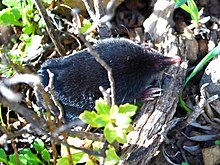Broad-footed mole
| Broad-footed mole | |
|---|---|
 |
|
| Scientific classification | |
| Kingdom: | Animalia |
| Phylum: | Chordata |
| Class: | Mammalia |
| Order: | Eulipotyphla |
| Family: | Talpidae |
| Genus: | Scapanus |
| Species: | S. latimanus |
| Binomial name | |
|
Scapanus latimanus (Bachman, 1842) |
|
 |
|
| Broad-footed mole range | |
The broad-footed mole (Scapanus latimanus) is a species of mammal in the family Talpidae. It is found in Baja California in Mexico and in California, Nevada and Oregon in the United States at elevations up to 3000 m above sea level.
The broad-footed mole can be distinguished from other species of Scapanus by its dark brown to silvery fur, and 40-44 unevenly spaced unicuspid teeth. Adults range from 14 to 18 cm in total length on average, with males slightly larger than females. Populations in more humid environments also tend to have larger individuals than those from southern, drier areas.
Its karyotype has 2n = 34, FN = 64. As with most moles, it requires moist, friable soils, where it eats earthworms, insects, other invertebrates and some plant matter.
Up to 12 subspecies of S. latimanus have been recognized, but a taxonomic revision published in 2004 recommended the southernmost subspecies, S. l. anthonyi (Anthony's Mexican mole) be elevated to full species, and recognized only 5 subspecies of S. latimanus. Anthony's Mexican mole is the smallest species (or subspecies) in the genus Scapanus and differs from S. latimanus in dental and cranial characteristics.
...
Wikipedia

